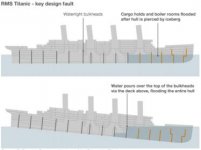I’d certainly be interested in the concept of contamination during rolling, the only things I’ve seen is rolled in debris and skin lamination, the RID is usually scalebraker failure and foreign object ( old nuts and bolts etc) the skin lamination is not applicable as it’s a continuous cast slab thing, mould powder aka slag gets entrained in the steel during casting then when rolled it turns into a dirty streak below the surface, sometimes hundreds of meters long, forms a kind of blister, all the ships were on about including Liberty were ingot route steel, mostly a kind of ingot called bottle top aluminium killed
With this you fill the ingot mould, throw in a couple of bags of Ali, drop a lid on shove a bar through to hold the lid down and get ou the way, the reaction brings the steel up to the lid really fast, kind of foams up almost, you had to time it with a stopwatch “ hit cap time”, too long insufficient Ali, to quick too much plus high oxygen activity, once the ingots were stripped from the mould the ends got cropped in a crop shear, crap gone
I’m sure there are ways to contaminate that I don’t know of, but I can’t think of any.
I’m going to stick with Phos myself, there is another phenomenon called lamellar tearing with plate steels, you have to control a thing called “carbon equivalent “ or C,E.V, there are formulas, carbon plus manganese plus this and that divided by 10 times blah blah, they can get really silly sometimes, in length of formula not importance, but they tend to apply to welded structures and post weld treatment, shrink and tear so Liberty ships would be affected
I think the titanic was quantity not quality myself, really rough work on the hull, the interior was par excellence at least for the first class bit,
There’s the remains of a Liberty ship you can see sticking out my local beach
It was the San Tampa, ran aground, still there, a friend of mine who I also worked with was there as a kid, he described the poor guys who drowned lined up on the beach, hard to get your head round is life
Mark



